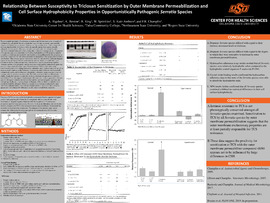| dc.contributor.author | Rigsbee, A. | |
| dc.contributor.author | Benton, A. | |
| dc.contributor.author | King, B. | |
| dc.contributor.author | Sprinkles, W. | |
| dc.contributor.author | Katz-Amburn, S. | |
| dc.contributor.author | Champlin, F. R. | |
| dc.date.accessioned | 2020-05-05T19:37:58Z | |
| dc.date.available | 2020-05-05T19:37:58Z | |
| dc.date.issued | 2020-02-28 | |
| dc.identifier | ouhd_rigsbee_relationshipbetweensusceptivity_2020 | |
| dc.identifier.citation | Rigsbee, A., Benton, A., King, B., Sprinkles, W., Katz-Amburn, S., & Champlin, F. R. (2020, Feb. 28). Relationship between susceptivity to triclosan sensitization by outer membrane permeabilization and cell surface hydrophobicity properties in opportunistically pathogenic Serratia species. Poster presented at Research Day at Oklahoma State University Center for Health Sciences, Tulsa, OK. | |
| dc.identifier.uri | https://hdl.handle.net/11244/324243 | |
| dc.description.abstract | BACKGROUND: The nosocomial opportunists Pseudomonas aeruginosa and Serratia marcescens are atypically resistant to the hydrophobic biocide triclosan due largely to outer membrane impermeability properties for hydrophobic substances. However, we have recently shown that the degree of cell envelope impermeability for triclosan differs dramatically among other opportunistically pathogenic Serratia species. Moreover, susceptivity to sensitization to triclosan by outer membrane premeabilization also differs among other intrinsically resistant species. The purpose of the present study was to determine if cell surface hydrophobicity (CSH) properties underlie susceptivity to triclosan sensitization by outer membrane premeabilization in selected species as we further characterize their cell surface properties in anticipation of investigating their propensities to form in vitro biofilms. | |
| dc.description.abstract | METHODS: Three Serratia species (marcescens, fonticola, and odorifera) exhibiting disparate degrees of susceptivity to triclosan sensitization by outer membrane premeabilization were examined to determine their susceptibility levels to mechanistically-disparate hydrophobic molecules and their CSH properties. Intrinsic resistance to hydrophobic antibacterial agents was assessed using a standardized disk agar diffusion bioassay. CSH was determined using conventional crystal violet binding, hydrocarbon adherence, and 1-N-phenylnapthylamine uptake assays routinely employed in this laboratory. | |
| dc.description.abstract | RESULTS: S. marcescens and S. fonticola were intrinsically resistant to all mechanistically-disparate hydrophobic antibacterial agents examined to include triclosan, while S. odorifera was susceptible. The CSH properties of all these differed only slightly, despite the disparate susceptivities of the two triclosan-resistant species to triclosan sensitization. | |
| dc.description.abstract | CONCLUSION: These data suggest that phenotypic differences seen in three opportunistic Serratia species with regard to intrinsic resistance to hydrophobic antibacterial agents in general, and triclosan specifically are at least due in part to disparate abilities of their outer membranes to exclude hydrophobic substances. Moreover, susceptivity to triclosan sensitization by outer membrane premeabilization in the triclosan-resistant species S. marcescens and S. fonticola appears not to be influenced by differences in cell surface hydrophobicity properties. | |
| dc.format | application/pdf | |
| dc.language | en_US | |
| dc.publisher | Oklahoma State University Center for Health Services | |
| dc.rights | The author(s) retain the copyright of have the right to deposit the item giving the Oklahoma State University Library a limited, non-exclusive right to share this material in its institutional repository. Contact Digital Resources and Discovery Services at lib-dis@okstate.edu or 405-744-9161 for the permission policy on the use, reproduction or distribution of this material. | |
| dc.title | Relationship between susceptivity to triclosan sensitization by outer membrane permeabilization and cell surface hydrophobicity properties in opportunistically pathogenic Serratia species | |
| osu.filename | ouhd_rigsbee_relationshipbetweensusceptivity_2020.pdf | |
| dc.type.genre | Presentation | |
| dc.type.material | Text | |
| dc.subject.keywords | serratia species | |
| dc.subject.keywords | triclosan | |
| dc.subject.keywords | cell surface hydrophobicity | |
